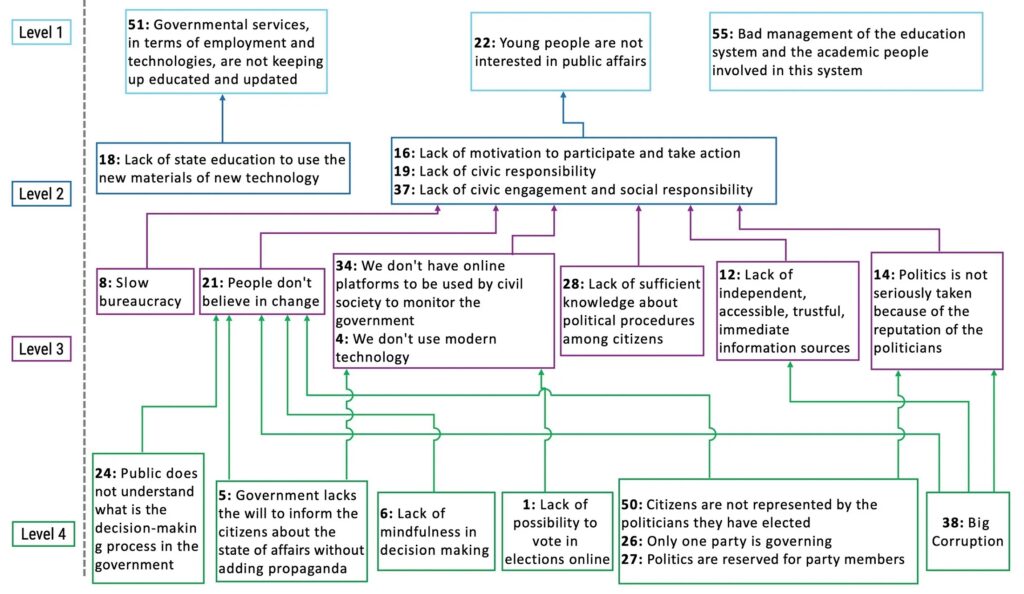
Structured dialogical design
By Yiannis Laouris. Originally published on the Integration and Implementation Insights blog.
How can heterogeneous groups reach consensus on complex issues in a reasonably limited amount of time? What kind of process allows for meaningful community involvement that is genuinely participatory and democratic?
Structured Dialogical Design is a process that achieves both these aims. The key aspects of the process and steps are presented.
Triggering questions
Structured Dialogical Design processes are always structured around triggering questions, which frame the discussions and help define the stakeholders of the issues under consideration. The idea is that those primarily concerned with and/or affected by the issues under consideration should become the primary participants.
For Structured Dialogical Design all stakeholders (or their representatives) concerned with the issues at stake must be included, including those seemingly without a voice (which many of us may not be hearing and are not responsive to listening to, such as the voice of nature). Thus, Structured Dialogical Design also resonates with Indigenous people’s epistemology and axiology.
In general, a Knowledge Management Team comprising of the dialogue host, one or two participants and at least one Structured Dialogical Design facilitator meets to formulate one or more triggering questions, which provide an initial frame for the dialogue.
This team also examines whether the invited participants meet the requisite variety criterion: ie., whether they represent a rich spectrum of interests and points of view, which is essential if the consensus to be generated is to be widespread and groupthink is to be tackled.
The triggering question serves to kindle targeted responses and to assist the facilitator in keeping the dialogue focused.
Examples of triggering questions, from a project on reinventing democracy (Laouris and Romm, 2022), are:
- What are the shortcomings of our current systems of governance that could be improved through technology; and
- What concrete action, project, or product would you propose to solve a particular shortcoming of current systems of governance?
The steps of the Structured Dialogical Design process are illustrated in the figure below.
Step 1: Idea generation
The first step of the dialogue is the generation of observations concerning the problematic situation in response to the triggering question. Each participant is invited in a round-robin manner to contribute one response at a time as a single statement (like a label), which should contain only one specific observation. This is important because, when observations are examined for similarity between them or influence on one another, if one statement contains several ideas or is too general, the process is compromised.
Contributions are numbered and attributed to the specific participants. This step takes 1–2 hours. Giving individuals space to generate and express their ideas without criticism from others helps to counter groupthink and encourages active listening.
Step 2: Clarification
Once all the observations have been collected, each participant clarifies the idea behind their statement. The process might take several hours. During the clarification process, others can ask questions about meaning, but no judgment is allowed. This facilitation technique is intended to protect the autonomy and authenticity of participants so that no participant is discouraged, and no idea is prematurely evaluated and/or rejected.
Step 3: Clustering
This step involves the categorization of observations using a bottom-up approach. This process takes much longer than top-down clustering methods, because it encourages discussion. Evolutionary learning takes place as the participants are encouraged to explore how specific aspects of their ideas might make them similar to other ideas; a process that forces them to draw further distinctions.

Step 4: Importance voting
Individual participants are asked to choose typically five out of the total set of ideas according to their perceived importance. The relative importance of an idea can be understood only when it is compared with the ideas of others (it is rare for people to choose only their own ideas as most important).
Step 5: Interpretive Structural Modelling
All the ideas that receive votes (ie., those that participants consider as the most important) enter the Interpretive Structural Modeling step. Using specialised software (eg., Cogniscope, Concertina, Logosophia), participants are exposed to two ideas at a time (to reduce cognitive load) and are requested to discuss them and decide whether one influences the other.
A relationship between the ideas is established only when it is supported by a large majority (typically 75%) following constructive debate. The binary connections that are established by the group are used to build up an influence map. An example is shown in the figure below. The mapping step might require a few hours.
Meaning and wisdom are produced only when the participants begin to understand the relationships (such as similarity, priority, influence, etc.) among their different ideas. The influence map reflects the shared understanding and the consensus of the participants. If the dialogue is about actions, those at the root have the greatest leverage for change. In the example below, which was about challenges, those at the bottom of the structure (Level 4) correspond to the root causes of the problem, hence the method is also referred to as ‘root cause mapping’.
Participants engage in further discussions on how to resolve obstacles at the root, and as these aggravate all those further up the structure, the idea is that addressing the root causes should have positive knock-on effects throughout the interlinked system of issues that the participants want to tackle.

Application and modifications
Structured Dialogical Design has been applied in more than 100 different contexts, including peace and conflict resolution, government and societal challenges, discovering and collectively agreeing on research agenda priorities (thus influencing European Commission funding), the support and capacity building of youth and civil society, envisioning and designing new educational systems, and reinventing democracy.
In most cases, the Structured Dialogical Design process has been a one-off intervention and the lack of an orchestrated set of follow up activities makes it difficult to evaluate the possible impact. More recently, colleagues and I have begun to experiment with a new approach to using the Structured Dialogical Design process, where it becomes just one among a number of systems approaches used in a coordinated manner to address issues where the Structured Dialogical Design process methodology on its own would not suffice (eg., Laouris and Michaelides, 2018; Michaelides and Laouris, 2024).
The process described here relies on face-to-face interaction. Virtual models and hybrid applications (ie., combinations of face-to-face with virtual synchronous or asynchronous phases) can engage larger numbers and reduce the time required in face-to-face interactions (see Laouris and Christakis, 2007; Laouris and Dye, 2024).
Concluding questions
If you have experience with Structured Dialogical Design, what are the main lessons that you would share? If this is a new process for you, what uses can you foresee?
To find out more:
Laouris, Y. and Christakis, A. N. (2007). Harnessing collective wisdom at a fraction of the time using Structured Dialogic Design Process in a virtual communication context. International Journal of Applied Systemic Studies, 1, 2: 131-153.
Laouris, Y. and Dye, K. (2024). Multi‐stakeholder structured dialogues: Five generations of evolution of dialogic design. Systems Research and Behavioral Science, 41, 2: 368-389.
Laouris, Y. and Michaelides, M. (2018). Structured democratic dialogue: An application of a mathematical problem structuring method to facilitate reforms with local authorities in Cyprus. European Journal of Operational Research, 268, 3: 918-931.
This was the primary source for this i2Insights contribution, with much of the text used verbatim.
Laouris, Y. and Romm, N. R. (2022). Structured dialogical design as a problem structuring method illustrated in a Re-invent democracy project. European Journal of Operational Research, 301, 3: 1072-1087.
Michaelides, M. and Laouris, Y. (2024). A cascading model of stakeholder engagement for large-scale regional development using structured dialogical design. European Journal of Operational Research, 315, 1: 307-323.
All papers provide key references and examples.
Generative Artificial Intelligence statement: Generative artificial intelligence (AI) was not used in the development of this i2Insights contribution. (For i2Insights policy on generative AI please see https://i2insights.org/contributing-to-i2insights/guidelines-for-authors/#artificial-intelligence.)
Biography:
 |
Yiannis Laouris (MD, PhD in Neurophysiology and PhD in Systems Engineering) is known for his socially responsible work and scientific contributions in the fields of peace, democracy, and development through the application of modern technology and Dialogical Design Science. He currently serves as President Elect (2024-2027) for the International Society for the Systems Sciences and Chief Executive Officer of Future Worlds Center and Head of its Futures Design Unit. He is also Director of Ekkotek high-tech business incubator and GNOUS Labs Ltd. He is based in Cyprus. |
Article source: Structured dialogical design. Republished by permission.
Header image source: iStock.




